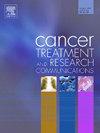Observation of acute toxicity events in lung cancer patients treated concurrently with a tyrosine kinase inhibitor
IF 2.4
Q3 Medicine
引用次数: 0
Abstract
Introduction
Tyrosine kinase inhibitors (TKIs) have led to improvements in the management of non-small-cell lung cancer (NSCLC), though toxicity profiles of combined TKI and radiation therapies remains unclear. We set out to determine if concurrent TKI therapy increases risk for acute esophageal or pulmonary toxicity following thoracic radiation.
Materials & methods
We performed a retrospective study of patients receiving thoracic radiation for NSCLC from March 2011–December 2021. Concurrent TKI use included drug use within three months of radiation. Patients receiving concurrent therapy were compared to those receiving radiation alone for CTCAE acute toxicity within 12 months of radiation. Probit models were generated to derive normal tissue complication probability (NTCP) curves for toxicity outcomes.
Results
95 patients received lung radiation with a median follow-up of 12 months (range=5–114 months) of which 15.8 % (n = 15/95) patients received concurrent TKI. The rate of grade 2–3 acute esophagitis was 21.3 % (17/80) and 53.3 % (8/15) for patients receiving radiotherapy without and with concurrent TKI, respectively (p = 0.010). Concurrent TKI use was associated with more grade 2–3 esophagitis (OR=4.24, 95 % CI=1.34–3.34, p = 0.014). NTCP analysis showed concurrent TKI was associated with lower TD50 values for all dosimetric constraints for ≥ grade 2 esophagitis. There were no differences in pulmonary toxicity.
Conclusions
Concurrent TKI therapy may contribute to radiosensitization of the esophagus during thoracic radiotherapy. However, there were no grade 4–5 toxicity outcomes, suggesting feasibility of this approach. Further investigation is warranted to determine potential complications and identify approaches to mitigate risk in multimodality therapy.
同时使用酪氨酸激酶抑制剂治疗肺癌患者的急性毒性事件观察
酪氨酸激酶抑制剂(TKIs)已经改善了非小细胞肺癌(NSCLC)的治疗,尽管TKI联合放射治疗的毒性谱尚不清楚。我们开始确定同时进行TKI治疗是否会增加胸部放疗后急性食管或肺毒性的风险。材料,方法:我们对2011年3月至2021年12月期间接受胸部放射治疗的NSCLC患者进行了回顾性研究。同时使用TKI的患者包括放射治疗三个月内的药物使用情况。同时接受治疗的患者与单独接受放疗的患者在12个月内的CTCAE急性毒性进行比较。生成概率模型以获得毒性结果的正常组织并发症概率(NTCP)曲线。结果95例患者接受肺放射治疗,中位随访12个月(范围5 ~ 114个月),其中15.8% (n = 15/95)患者同时接受TKI治疗。单纯放疗和合并TKI患者2-3级急性食管炎发生率分别为21.3%(17/80)和53.3% (8/15)(p = 0.010)。同时使用TKI与更多的2-3级食管炎相关(OR=4.24, 95% CI= 1.34-3.34, p = 0.014)。NTCP分析显示,对于≥2级食管炎的所有剂量学限制,并发TKI与较低的TD50值相关。两组肺毒性无差异。结论胸椎放射线治疗期间,TKI同步治疗可能有助于食管的放射增敏。然而,没有4-5级的毒性结果,表明这种方法是可行的。进一步的调查是必要的,以确定潜在的并发症,并确定方法,以减轻多模式治疗的风险。
本文章由计算机程序翻译,如有差异,请以英文原文为准。
求助全文
约1分钟内获得全文
求助全文
来源期刊

Cancer treatment and research communications
Medicine-Oncology
CiteScore
4.30
自引率
0.00%
发文量
148
审稿时长
56 days
期刊介绍:
Cancer Treatment and Research Communications is an international peer-reviewed publication dedicated to providing comprehensive basic, translational, and clinical oncology research. The journal is devoted to articles on detection, diagnosis, prevention, policy, and treatment of cancer and provides a global forum for the nurturing and development of future generations of oncology scientists. Cancer Treatment and Research Communications publishes comprehensive reviews and original studies describing various aspects of basic through clinical research of all tumor types. The journal also accepts clinical studies in oncology, with an emphasis on prospective early phase clinical trials. Specific areas of interest include basic, translational, and clinical research and mechanistic approaches; cancer biology; molecular carcinogenesis; genetics and genomics; stem cell and developmental biology; immunology; molecular and cellular oncology; systems biology; drug sensitivity and resistance; gene and antisense therapy; pathology, markers, and prognostic indicators; chemoprevention strategies; multimodality therapy; cancer policy; and integration of various approaches. Our mission is to be the premier source of relevant information through promoting excellence in research and facilitating the timely translation of that science to health care and clinical practice.
 求助内容:
求助内容: 应助结果提醒方式:
应助结果提醒方式:


